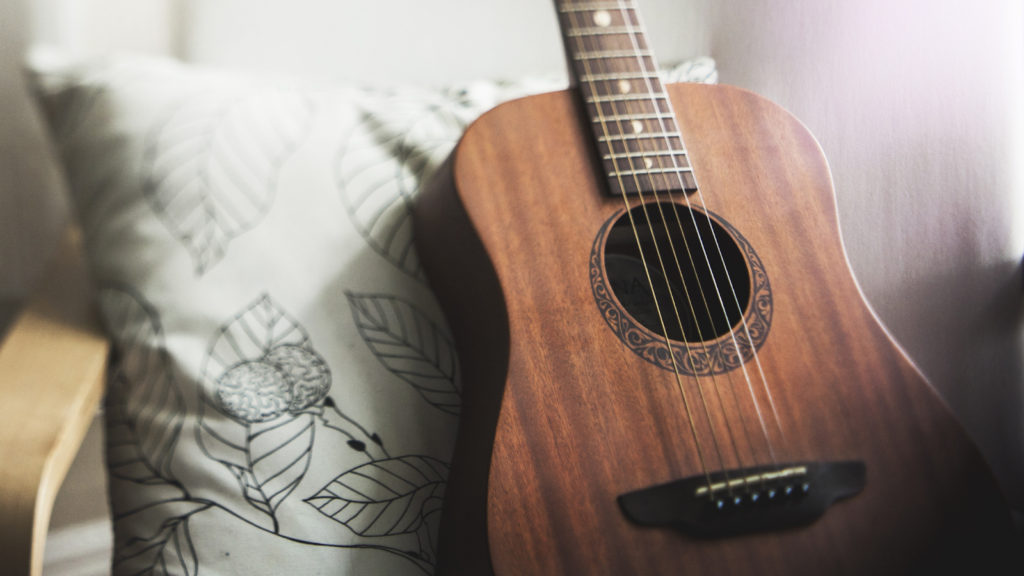Acoustic guitars, with their rich history and varied designs, are a cornerstone in the world of music. The world of acoustic guitars is vast and diverse, offering a range of sounds and styles to suit different musical genres and player preferences.
In this comprehensive guide, we’ll delve into the different types of acoustic guitars, focusing on a range of distinct styles, from the classical guitar to the flamenco guitar and so many more besides. By understanding each guitar’s unique features, string types, and associated musical genres, you’ll gain a deeper appreciation of these instruments and their role in the world of acoustic instruments.

Getting Technical: The History and Evolution of Acoustic Guitars
The acoustic guitar, with its rich history and evolution, has been a pivotal instrument in shaping music across the world. From its humble beginnings to the modern designs we see today, the journey of the acoustic guitar is a fascinating story of innovation, craftsmanship, and musical expression.
The Origins
Early Ancestors – The roots of the acoustic guitar can be traced back to ancient instruments like the lute and the oud, which were prevalent in Middle Eastern and European cultures. These early stringed instruments laid the foundation for the development of the guitar, both in terms of structure and playing technique.
The Renaissance and Baroque Eras – During the Renaissance, the vihuela, an instrument similar to the modern guitar, emerged in Spain. It had six double strings and was played in a manner similar to the lute. In the Baroque period, the five-course guitar became popular. It typically had nine or ten strings with a curved body, which started the evolution towards the shape we recognize today.
The Birth of the Modern Guitar
The Six-String Design – The transition to the six single-string format in the late 18th century marked a significant development. This change created easier tuning and allowed for a greater range of notes. Antonio de Torres Jurado, a Spanish luthier in the 19th century, is credited with designing the first modern classical guitar. His innovations in body shape and bracing patterns greatly influenced the guitar’s sound and volume.
Steel Strings and the American Influence – In the late 19th and early 20th centuries, American guitar makers began experimenting with steel, which produced a louder and brighter sound compared to the traditional gut strings. This period saw the rise of influential American guitar manufacturers like C.F. Martin and Orville Gibson. Martin’s X-bracing system, in particular, became a standard in steel-string guitar construction.
Key Innovations and Influential Luthiers
Innovations in Guitar Making – The 20th century witnessed significant innovations such as adjustable truss rods, improved bracing techniques, and the introduction of synthetic materials. The development of electric amplification in the 1930s led to the creation of acoustic-electric guitars, blending traditional acoustic tones with electronic versatility.
Influential Luthiers – Alongside Antonio de Torres and C.F. Martin, other notable luthiers like Orville Gibson and John D’Angelico made substantial contributions to guitar design. Modern luthiers continue to experiment with new materials and construction techniques, pushing the boundaries of what an acoustic can be.
The Acoustic Guitar in Contemporary Music
Today, the acoustic is a staple in numerous musical genres, from classical and flamenco to folk, blues, and rock. Its evolution is a testament to the creativity and ingenuity of luthiers and musicians who have shaped its development over the centuries.
The history and evolution of acoustic guitars is a story of continuous innovation and adaptation. From the early lutes and vihuelas to the modern steel-string and acoustic-electric models, each era’s craftsmen and musicians have left their mark on this versatile instrument. Understanding the acoustic guitar’s history enhances our appreciation of it, not just as a musical instrument but as a piece of cultural heritage that has echoed through the ages.
The Classical Guitar: Elegance in Simplicity
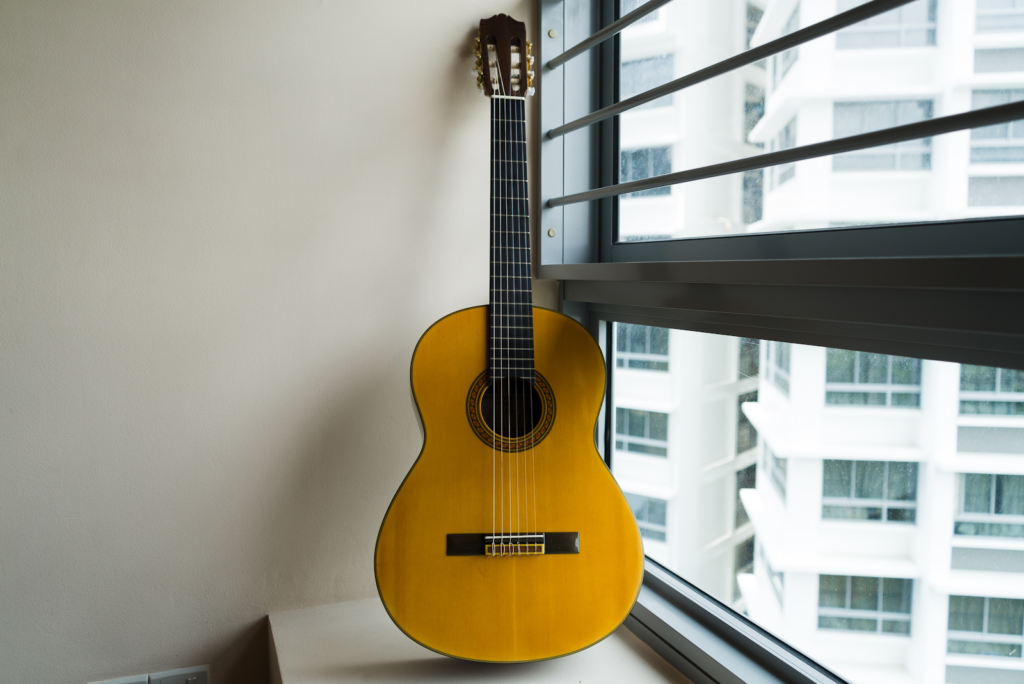
Classical guitars (also known as nylon string guitars) are renowned for their elegant design and mellow, warm tones. Characterized by its smaller body and wider neck, this guitar allows for intricate fingerstyle playing, making it a favorite among classical and folk musicians. The soundboard, typically made of cedar or spruce, contributes to its distinct sound.
Unlike steel string guitars, classical guitars use nylon strings, which are softer and produce a smoother, more mellow tone. This string type is particularly forgiving for beginners, as it is gentler on the fingers. It also makes it easier to play classical music.
Classical guitars are predominantly used in classical music compositions, but they are also popular in folk, Latin, and Flamenco. Their versatility allows players to explore a range of musical styles, from intricate classical pieces to rhythmic Latin tunes.
Prices for the best classical guitar don’t have to break the bank. Beginners can get their hands on many amazing nylon string guitars for under $500.
The Flamenco Guitar: A Rhythmic Marvel
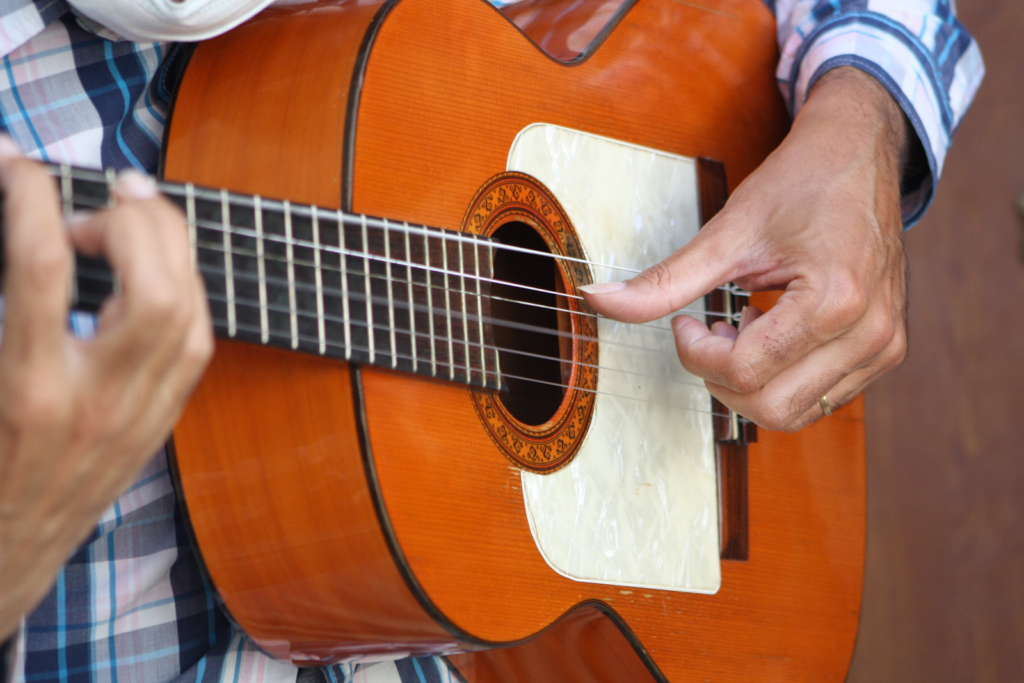
The flamenco guitar may closely resemble the classical guitar, but it’s designed for the fiery and percussive style of Flamenco. It typically has a thinner top and a shallower body compared to classical guitars, which helps produce a sharper, brighter sound. Additionally, flamenco guitars often have a clear tap plate (known as the golpeador) to protect the guitar from the rhythmic tapping that is integral to Flamenco music.
Like classical guitars, flamenco guitars use nylon strings. However, these guitars are set up with a lower guitar action, encouraging faster and more percussive playing styles.
As the name suggests, flamenco guitars are primarily used in Flamenco music, a genre that originated in Andalusia, Spain. This style is known for its fast-paced rhythms and passionate delivery, making the flamenco guitar a key component in creating its distinctive sound.
The Jumbo Acoustic Guitar: Bold and Powerful

The jumbo guitar is the largest of the standard acoustic body shapes. It’s known for its large, deep body, which creates a powerful, resonant sound. This guitar type is ideal for strumming and provides a rich, full tone that can fill a room, making it a popular choice for live performances.
Jumbo acoustic guitars typically use steel, contributing to their loud, bright, and crisp sound. The tension of steel, coupled with the guitar’s large body, creates a dynamic range that is well-suited for a variety of musical styles.
Jumbo acoustic guitars are versatile and can be found in a range of music genres, from country music and folk to rock and pop. Their robust sound makes them particularly effective for rhythm guitarists and singer-songwriters who require a strong acoustic presence.
The Parlor Guitar: Compact Charm and Versatility
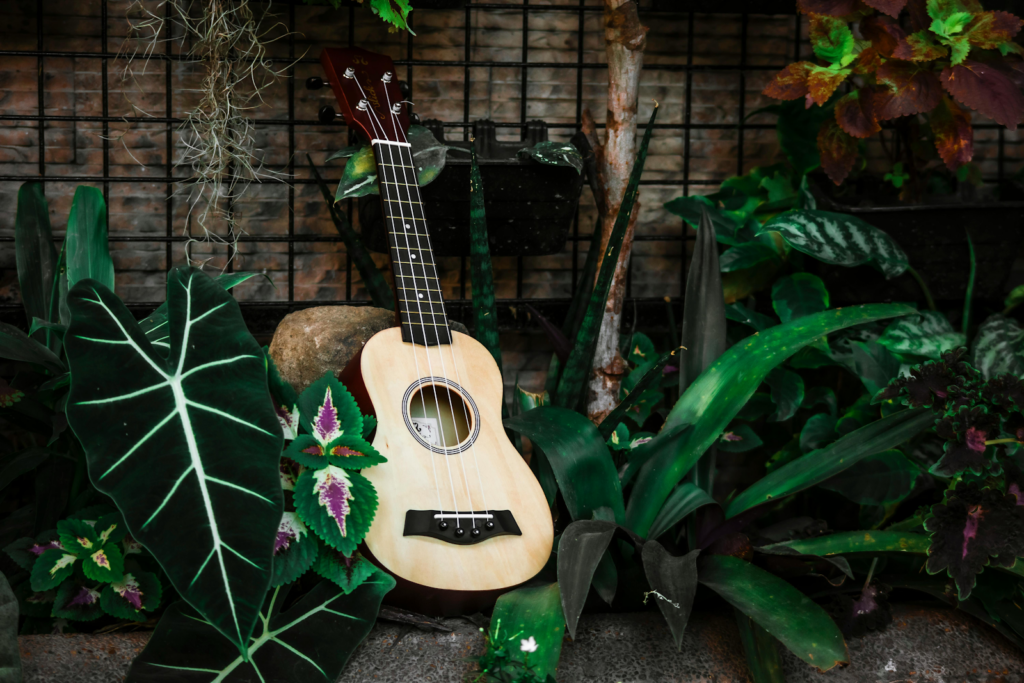
The parlor guitar, known for its smaller size and intimate sound, is a throwback to the early days of acoustic guitars. Its compact body makes it highly portable and comfortable for players of all sizes. Despite its smaller size, the parlor guitar delivers a surprisingly full and balanced tone, which is why it’s such a favorite for blues and folk musicians.
Parlor guitars are typically strung with steel, offering a bright, clear tone that belies their small size. This string type complements the guitar’s design, allowing for a wide range of tonal expressions, from soft fingerpicking to more aggressive strumming.
Parlor guitars are versatile instruments, often used in blues, folk, and singer-songwriter genres. Their clear, focused sound makes them a popular choice for solo performers and recording artists.
The Grand Concert: A Balance of Size and Sound

The grand concert acoustic guitar strikes a balance between size and sound. Smaller than a dreadnought but larger than a parlor guitar, it offers a comfortable playing experience without sacrificing tonal quality. Its design focuses on delivering a balanced sound with good volume and clarity, making it suitable for both fingerstyle and flat-picking techniques.
When it comes to strings, grand concert guitars are equipped with either nylon or steel, depending on the manufacturer and model. This versatility allows musicians to choose the string type that best suits their style and desired sound.
The grand concert guitar’s balanced tone and versatile design make it suitable for a wide range of music genres, including folk, classical, jazz, and pop. Its adaptability to different playing styles makes it a popular choice among diverse musicians.
The Dreadnought Guitar: The Standard of Power and Volume

The dreadnought guitar is one of the most popular and recognized acoustic guitar body shapes. Its large body and broad waist produce a powerful, resonant sound with deep bass and strong volume. The dreadnought’s design is optimized for a robust sound projection, making it a favorite in ensemble settings and for solo performances that require a commanding acoustic presence.
Dreadnought guitars are typically strung with steel, which contributes to their loud, bold sound. Steel strings enhance the guitar’s natural volume and bass response, making it ideal for powerful strumming and rhythm playing.
Dreadnought guitars are extremely versatile and are used in a variety of musical genres, including country, rock, bluegrass, and folk. Their robust sound and strong projection make them ideal for both recording and live performance settings.
The Acoustic-Electric Guitar: Best of Both Worlds
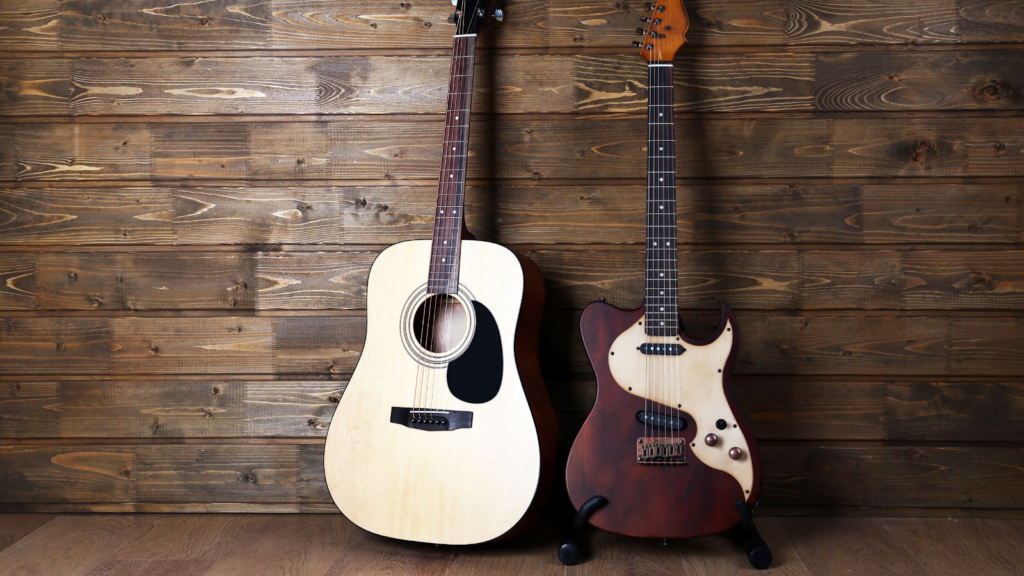
The acoustic-electric guitar is a fusion that brings together the classic acoustic experience with modern amplification technology. It looks like a traditional acoustic guitar but comes equipped with electronic components like pickups and preamps. This design allows the guitar to be played acoustically or plugged into an amplifier or PA system without losing that natural acoustic sound.
Acoustic-electric models can be strung with either steel or nylon, depending on the model and intended use. Steel is common in pop, rock, and folk, while a nylon string guitar is preferred in classical and jazz genres.
The versatility of acoustic-electric models makes them ideal for a wide range of musical styles. They are especially popular among performers who play in various settings, from intimate acoustic sessions to larger live performances. The ability to amplify the sound without compromising its quality makes these guitars a favorite in genres like pop, rock, country, and folk.
The Travel Acoustic Guitar: Music On-the-Go

Travel acoustic guitars are designed for portability and ease of transport, making them perfect for musicians on the go. These guitars are significantly smaller and lighter than standard acoustic guitars, but they still offer a quality sound and playing experience. They often feature innovative designs that maximize sound in a compact form.
Most travel guitars use steel for their strings, chosen for their bright, crisp sound that compensates for the guitar’s small body shape. Steel strings help project a clear tone, ensuring that the guitar’s sound is not overly diminished by its reduced size.
Travel guitars are suitable for a variety of musical styles but are particularly popular among folk, pop, and singer-songwriter musicians. Their portability makes them perfect for impromptu performances, songwriting sessions while traveling, or as a convenient option for practice and casual playing.
Choosing the Right Acoustic Guitar for Your Style
Selecting the right acoustic can be as personal and unique as the music you intend to play on it. The choice of an acoustic guitar can significantly influence your style, comfort, and the sound you produce.
Here are some guidelines to help you choose an acoustic guitar that aligns with your playing style, genre preferences, and level of expertise.
Assess Your Style and Genre
Fingerstyle or Flatpicking – If you prefer fingerstyle, look for guitars with a wider neck, like classical guitars, which offer more space between strings for intricate finger movements. Flatpickers might lean towards steel-stringed guitars, like dreadnoughts or jumbo acoustic models, known for their robust sound and volume.
Musical Genre Preferences – For classical, flamenco, or Latin music, classical guitars with nylon strings are ideal. Steel string acoustic guitars, including dreadnought and jumbo models, are suited for genres like country, rock, folk, and bluegrass music. If you play a variety of genres, consider versatile models like grand concert or grand auditorium guitars, which offer a balance of sound suitable for multiple styles.
Consider Your Level of Expertise
Beginners – As a beginner, comfort should be your priority. Look for guitars with a comfortable neck and easy playability. Parlor guitars or smaller acoustic guitar body shapes are often recommended for beginners due to their manageable size. Nylon string classical guitars can also be a good starting point as they are easier on the fingers.
Intermediate to Advanced Players – Advanced players might prefer guitars that offer more tonal complexity and responsiveness, like higher-end dreadnoughts or grand concert models. Consider the craftsmanship, such as solid wood tops or specific wood types that match the sound quality you’re seeking.
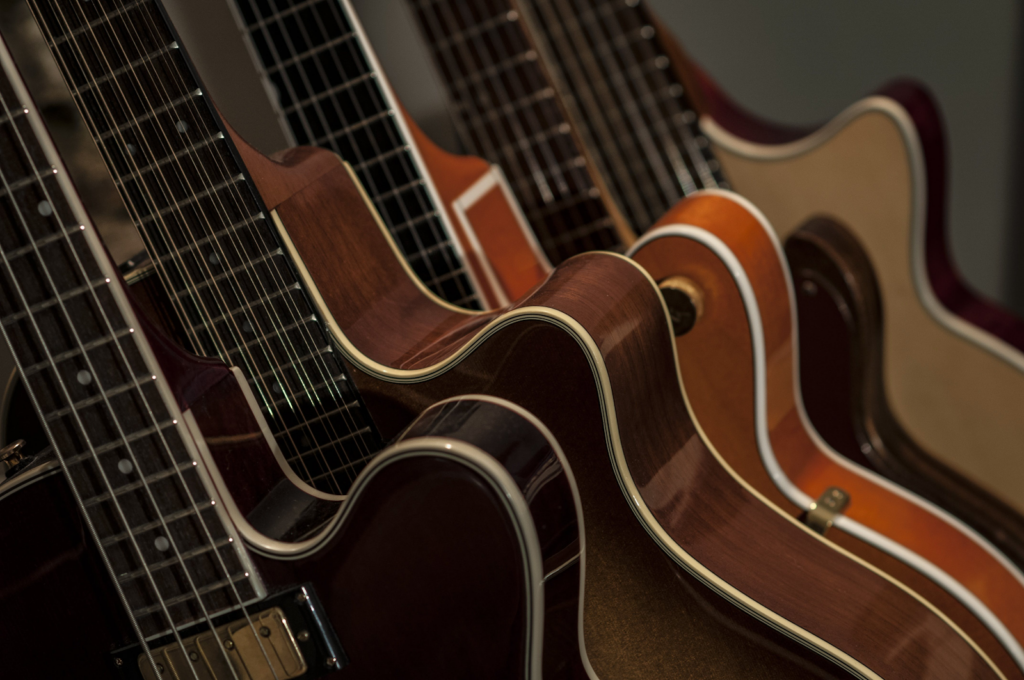
Experiment with Different Body Sizes
Small Body Guitars (Parlor, Grand Concert) – These are ideal for players who prioritize comfort and a more intimate sound. They’re also suitable for fingerstyle and light strumming.
Medium Body Guitars (OM, Auditorium) – They offer a balanced sound, suitable for both strumming and fingerpicking, making them a good all-around choice for varied playing styles.
Large Body Guitars (Dreadnought, Jumbo) – Larger guitars are best for players who want volume and a full, resonant sound. They’re ideal for aggressive strumming and rhythm playing.
Understand the Importance of Wood and Construction
The type of wood affects the guitar’s tone. Spruce tops offer brightness, while mahogany provides a warmer sound. You should also consider whether the guitar has a solid top or laminate, as solid tops generally provide better sound quality.
You also don’t want want skimp on construction. Look at the guitar’s build quality, including the joint construction, finishing, and setup. Rememeber, a well-constructed guitar not only plays and sounds better but also lasts longer. It might be worth investing in a slightly more expensive model if you’re serious about playing the guitar.
But that doesn’t mean you shouldn’t consider a budget.
Set a Budget
For those on a budget, there are many quality entry-level guitars that provide great value. Consider reputable brands that are known for their quality control even in lower price ranges.
More serious players might find that investing in a higher-end guitar can be worthwhile for the improved sound quality and craftsmanship. If you’re undecided about splashing the cash, consider it a long-term investment in your musical journey.
Try Before You Buy
The most important aspect of choosing a guitar is how it feels and sounds to you. If you can, spend time playing different guitars in your local music store, or ask to try your friends’ guitars as an alternative. Pay attention to how the neck feels in your hand, the ease of playing, and the sound it produces.
Choosing the right acoustic guitar is a personal journey that should be approached with careful consideration of your individual needs and preferences. By understanding your style, musical genre, and level of expertise, you’re well on your way to finding an instrument that will be a joy to play for years to come. Remember, the best guitar for you is one that feels right in your hands and resonates with your musical soul.
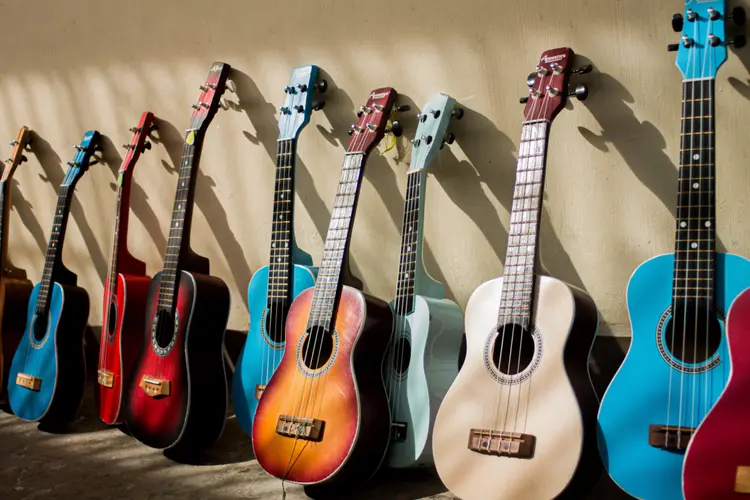
Caring for Your Acoustic Guitar
Proper maintenance and care are essential if you want to keep your acoustic guitar in top playing condition. Not only does regular care extend the life of your guitar, but it also ensures it sounds its best.
Not sure where to start? We’ve got you covered. Here’s a guide to some of the key aspects of acoustic guitar maintenance.
Understanding Humidity and Temperature
Acoustic models are sensitive to humidity changes. Too much humidity can cause the wood to swell, while too little can cause it to crack. Ideally, keep your guitar in an environment with relative humidity ranging from 45-55%.
Extreme temperatures can also damage your guitar. Avoid exposing it to direct sunlight, high heat, or freezing conditions. Obviously, this can be a difficult ask for traveling musicians and buskers. However, many travel guitars are made with materials designed to battle different weather conditions. Furthermore, when traveling, it’s important to transport your guitar in a hard case to protect it from temperature variations.
Regular String Changing
It’s important to know when to change your strings. Strings should be changed regularly, depending on how often you play. Even if you don’t play your guitar often, strings can still lose their tone over time. As a general rule, change your strings every 3 to 6 months.
Make sure to familiarise yourself with the proper technique for changing strings to avoid damaging the guitar. Ensure that the strings are wound correctly and that the bridge and neck are not put under unnecessary tension.
Cleaning and Polishing
It’s important to clean your guitar regularly, especially if you’re exposing it to the elements. Gently wipe down your guitar with a soft, dry cloth after each use to remove fingerprints and dust. For more thorough cleaning, use a slightly damp cloth followed by a dry cloth. Avoid using household cleaners.
Use a guitar polish or a little bit of lemon oil on the fretboard to keep it looking fresh. However, do this sparingly – a couple of times a year is enough.
Fretboard and Bridge Care
The fretboard can become dry, especially in low humidity. Conditioning the fretboard with a specialized fretboard oil can help maintain its health. Be cautious with the amount of oil used; a little goes a long way.
It’s also important to regularly inspect the bridge and saddle for any signs of wear or damage. Issues here can affect intonation and playability.
Storage and Handling
When you’re not using your guitar, store it in a case to protect it from dust and changes in environmental conditions. If you’re hanging the guitar on the wall, make sure it’s not exposed to direct sunlight or air vents, as this can damage it.
Always handle your guitar gently. Avoid placing it in positions where it could easily fall or be knocked over.
Regular Check-ups
Consider having your guitar professionally set up once a year. A luthier or guitar technician can adjust the action, check the neck alignment, and ensure everything is in optimal condition.
It’s also important to keep an eye (and ear) out for changes in sound, playability, or the guitar’s structure. Early detection of issues can prevent more serious damage later down the line.
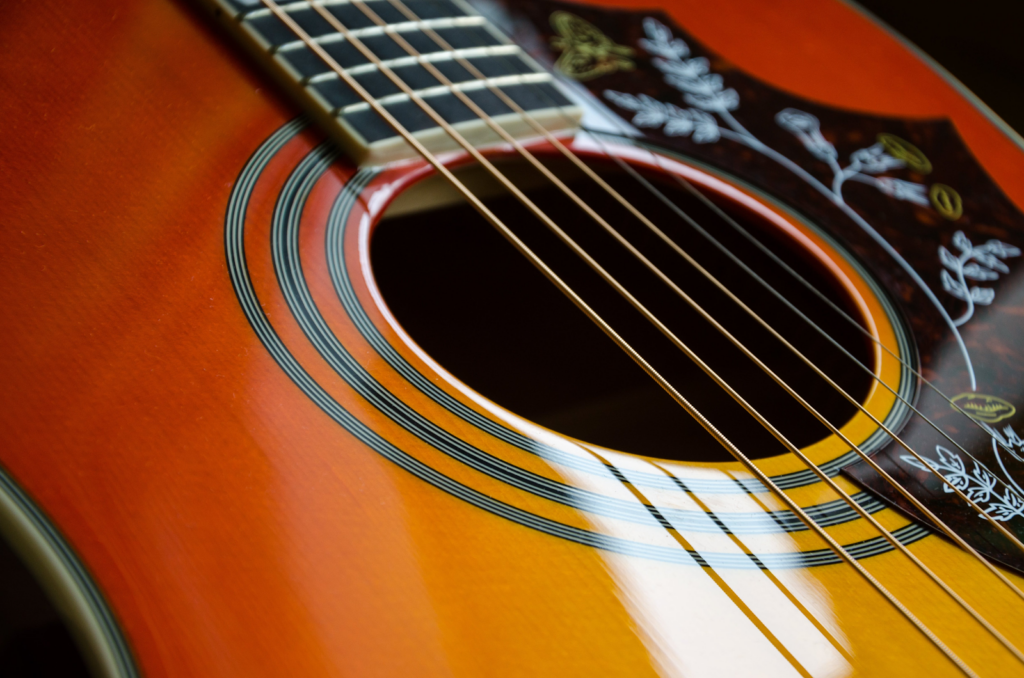
Conclusion: Celebrating the Diversity and Beauty of Acoustic Guitars
As we conclude our journey through the fascinating world of acoustic guitars, it’s clear that these instruments are so much more than just wood, strings, and craftsmanship. They are vessels of expression, with their own voice and characters, reflecting the diversity and richness of the music they create. From the elegant classical guitar to the bold jumbo acoustic and from the innovative acoustic-electric to the compact travel guitar, each type offers a unique gateway to musical exploration and enjoyment.
Understanding the different types of acoustic models, their historical evolution, and the nuances in their design and construction equips us with a deeper appreciation for these instruments. Whether you’re a beginner picking up a guitar for the first time or a seasoned player with years of experience, there’s always something new to discover in the acoustic guitar world. The key is to find the guitar that resonates with your style, your music, and your soul.


